Dedicated to the Art
and Artists
of Relief Printmaking
15685 SW 116th Ave
PMB 202
King City, OR
97224-2695 USA
Phone:
503-641-3555
FAX:
503-641-3591
Orders:
800-832-4264
www.imcclains.com
You can instantly unsubscribe from these newsletters at the bottom of this page.
Go to McClain's
On-line Catalog
Request a catalog |
August 2008
ALL ABOUT SOLARPLATES___________________________________ |
|
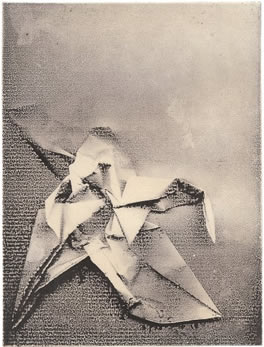
One Crane Alex Prentiss
Intaglio Solarplate Print
|
Solarplates offer a wide range of printmaking possibilities. In as little as 15 minutes you can have a plate ready for printing! Depending on the materials used to make the original artwork, your final image will look like an intaglio or relief print, a lithograph, silkscreen or linoleum block. Your prints can even have photographic qualities. The detail a Solarplate can hold is excellent. Another major benefit is that Solarplates are far less toxic than any other photo intaglio or photo relief method!
Basic Solarplate Information:
To make a Solarplate print, a piece of artwork is copied or created on transparent film. The film is laid on top of the Solarplate polymer, which is both light sensitive and water-soluble. When light from the sun (or any UV light source) hits the plate, it hardens. The parts of the plate blocked from light remain soluble and are washed away with tap water.
Either oil-based or soy-based inks can be used to create prints from Solarplates. Water-based ink can soften the photopolymer and are not recommended.
|
|
Tools and supplies needed for making Solarplates:
- Solarplates
- Exposure Unit or Sun
- Timer (a stop watch will do)
- Contact Print Frame
- Artwork in transparency form (negative image for Relief Prints, positive image for Intaglio Prints) or applied directly to the plate
- Aquatint Screen (for Intaglio Printing)
- Washout Area with water at a constant 68-78 degrees Fahrenheit
- Washout Brush
- Magnetic Vinyl attached to a Steel Tray
- Drying Equipment such as a hair dryer
- Newsprint or newspaper for blotting
- Safety equipment including (Nitrile Gloves, Impermeable Apron, Safety Goggles)
|
| |
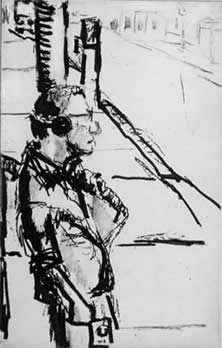
Beat F.X. Rosica
Intaglio Solarplate Print
|
|
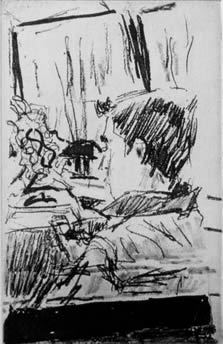
Leave it to Beaver F.X. Rosica
Intaglio Solarplate Print |
|
Exposing Solarplates:
- Remove Solarplate from light-tight storage and, keeping it in subdued light, cut to size if needed (use a box knife or a paper cutter designated for cutting Solarplates)
- Place Solarplate on the base of the contact print frame, with the emulsion, or polymer, face up
- For relief plates, position artwork on transparency emulsion side down onto the Solarplate (the emulsion side is the dull side)
- For intaglio plates, expose a second time with an Aquatint Screen. Place emulsion side down onto the Solarplate (the emulsion side is the dull side)
- Be sure your contact print frame glass is clean and clear of debris like lint and dust
- Clamp the frame closed, check that your transparency is still in the correct position on the Solarplate
- Warm up the lights on the exposure unit, or walk out into the sun with your contact print frame protected from the light
- Set your timer, place the contact print frame under the light source - turn on the timer
|
|
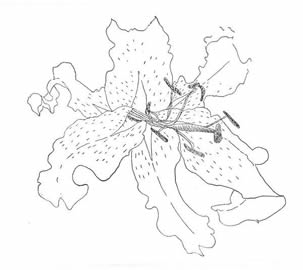
Tiger Lilly Catherine Kumlin
Relief Solarplate Print

Untitled Meda Cummings
Intaglio Solarplate Print
|
|
|
| Exposure times vary greatly depending on exposure unit, lamp age, your geographical location if using sunlight, density of your artwork and many other factors. In general, at noon with full sun, exposure takes around three minutes. For intaglio plates, expose the Aquatint Screen the same amount of time as the art work. |
| Before exposing your entire plate you should do test strips to determine exactly how much time your plate should be exposed to UV light. |

Swan Island Ship Yard, Portland Oregon Russ Dodd Intaglio Solarplate
|
|
Processing Solarplates:
- Take your contact print frame to the washout area
- Put on your apron, nitrile gloves and safety goggles
- Remove the Solarplate and transparency from the contact print frame
- Immerse the solarplate in the 68-78 degree water
- Gently but firmly scrub the solarplate with a soft bristled washout brush for 3-5 minutes for relief plates, 1-2 minutes for intaglio
- Remove the plate from the water allowing it to drain and drip dry for a moment
- Once the water slows to minimal drip, blot the plate with newsprint or newspaper
- Dry the plate thoroughly using a hair dryer
- Post expose the plate for approximately the same amount of time you initially exposed your plate, or until it is no longer tacky to the touch
|
| |
|
|
|
|
Solarplate Success Tips:
- Test! Test! Test! Always do test strips before attempting to process a final plate and take notes for future reference
- Keep a clean studio. Dust that gets trapped between your artwork and the plate can block the light causing voids which show in printing. A good way to avoid dust is to keep your air circulation filtered
- Keep humidity in your studio around 40-50%. Lower humidity can cause static electricity which attracts dust and debris
- Keep plates clear of finger prints - use Nitrile gloves if necessary
- Type below six points can be difficult to produce with Solarplates
- If your image has large solid areas, fine details, tints and half-tones it's best to separate these and use multiple plates to get the best final print
|
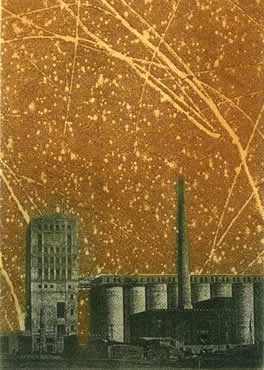
Warry Night Brandon Stahlman
A la Poupee Intaglio Solarplate Print |
|
|

Cheeky Halibuts Alex Prentiss
Relief Solarplate Print
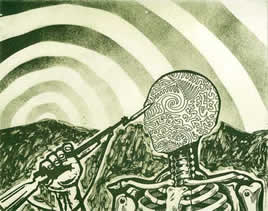
The End Brandon Stahlman
Intaglio Solarplate Print
|
|
Common Problems and their Causes:
- Problem: Image is not sharp
- Possible Cause: Poor contact between transparency and plate
- Problem: Whole image or parts of image washed away during wash out
- Possible Cause: Exposure was too short, thus not hardening any polymer
- Problem: No polymer/little polymer washed away during wash out
- Possible Cause: Exposure too long or plate has expired due to age or heat exposure
- Problem: Plate is sticky
- Possible Cause: Post exposure too short - expose another 5-10 minutes
- Problem: Detail of transparency isn't in the plate
- Possible Cause: Image on transparency isn't opaque enough or transparency was emulsion side up during exposure
- Problem: Plate is unevenly thick
- Possible Cause: Wash out too long or raw plates not stored properly (plates should be stored horizontally in a light tight, cool, dry place. Varying sizes should not be stacked on top of one another)
- Problem: Small holes or depressions in solid areas
- Possible Cause: Debris or dust was trapped in contact print frame
- Problem: Orange peel effect
- Possible Cause: Washout time too long
- Problem: Plate cracks when flexed
- Possible Cause: Post exposure too long
|
| |
|
|
|
| NEWS________________________________________________ |
The MAPC (Mid America Print Council) Conference will be held in Fargo North Dakota and its sister city, Moorhead Minnesota, from October 1st-5th. McClain's will be participating in the vendor fair, October 2nd-5th. We hope to see you there!
|
 |
Click here for more MAPC Conference info. |
| _________________________________________________________________________ |
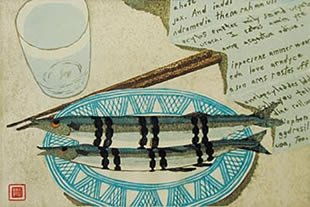
|
There are just a few more spots left in the Richard Steiner Moku Hanga Workshop taking place here in Portland, OR at Marylhurst University.
Click here to get more info. |
|
|











